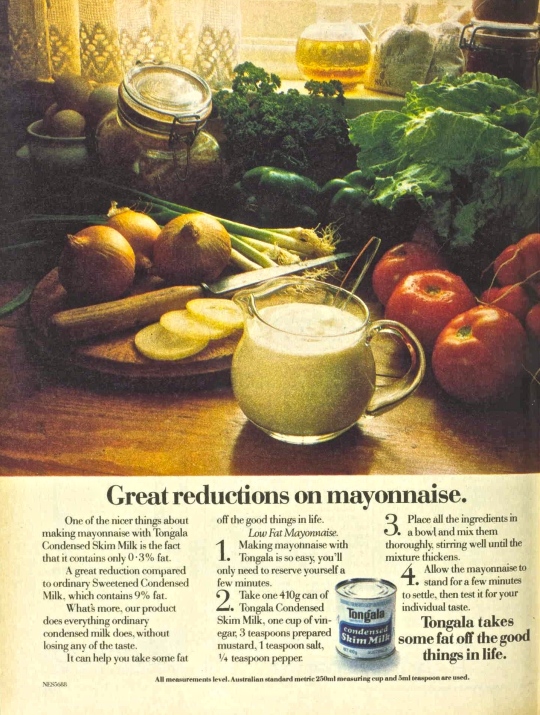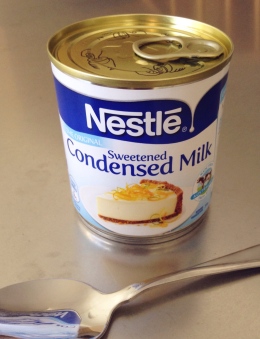What is it with kids and condensed milk? So many stories of children sneaking spoonfuls of the stuff, saving up to buy their own tubes or tins of it, using it to bargain or bribe each other. My brother had a great train set and I’d use the promise of condensed milk to persuade him to let me play with it. (Note to parents: girls like train sets.)
If kids and condensed milk go together like—well, kids and condensed milk, they’re not alone. There are two other groups of people strongly associated with it: housewives of the 1970s and soldiers.
Take a can of condensed milk … The product appeared frequently in The Australian Women’s Weekly, sometimes in the recipe pages, sometimes in advertisements. Take a 400g can of condensed milk … and make lemon curry mayonnaise (29 March 1978) or ‘take some fat off the good things in life’ and make a low fat version with Tongala Condensed Skim Milk (22 November 1978). And afterwards, if you fancy something sweet, then ‘Nestlé Sweetened Condensed Milk makes the most attractive Pineapple Flan for your family, and for you too.’ (28 February 1979)
My first cheesecake used condensed milk. I was a student working a summer job in a café, and one of the cooks gave me her recipe. It had the standard biscuit crumb base, and a no-cook filling that mixed Philadelphia cream cheese with condensed milk, and the juice and grated zest of a lemon. It was the only method I knew until years later a German friend introduced me to her baked cheesecake. A lighter and altogether more subtle confection.
I hadn’t had any contact with condensed milk for ages, until a few days ago when I bought a tin. To see what recollections—apart from that student cheesecake—it might prompt. I removed the lid (now a ring-pull) and dipped in a teaspoon. It was homemade fudge and caramel tarts and Indian sweets and the sound of those toy trains chuff-chuffing across the carpet. When my idea of heaven would have been reading an Enid Blyton adventure while digging into my own tin of condensed milk. Needless to say, neither my brother nor I were allowed our own unlimited supplies. But we could add a small amount to our bowls of summer berries or stone fruit—instead of ice-cream. After our ration had been doled out, the can went back in the fridge. And I marked the level on the paper sleeve to ensure no one (i.e. my brother) took an unauthorised mouthful.
‘”Shall I look too?” said Pooh, who was beginning to feel a little eleven o’clockish. And he found a small tin of condensed milk, and something seemed to tell him that Tiggers didn’t like this, so he took it into a corner by itself, and went with it to see that nobody interrupted it.’ The House at Pooh Corner.
Condensed milk is cow’s milk heated to remove much of the water content and then sweetened. It’s thick, sticky and dizzyingly sweet. You can make your own or buy it ready made. The sugar acts as a preservative, so sweetened condensed milk enjoys a longer shelf-life than evaporated milk. Along a dusty road on the outskirts of Mumbai I saw vendors selling snacks, plastic combs, T-shirts with English logos and McVitie’s biscuits with expiration dates long passed. Plastic thongs bounced on strings above pyramids of condensed milk cans. In places where access to refrigeration is limited, sweetening your tea or coffee with tinned milk makes good sense.
In 1908 Nestlé opened its first Australian branch, and in 1911 built what was then the world’s largest condensed milk plant in Dennington, Victoria. In January 1917 Adelaide’s Daily Herald ran a lengthy article entitled A Campaign for Patriotism and Production. Today we’d probably label it advertorial.
‘Australia’s fame as a dairying country is worldwide … There has sprung up within the past 10 years, however, a new industry, which promises to make Australia even more famous than heretofore, and about which the general public still have little conception. We refer to the manufacture of condensed milk … ’
The article-cum-extended advert goes on to say that:
‘Since commencing operations in Australia the company has made wonderful progress. Its motto is “Australia for the Australians,” and Nestlé’s in this country has developed into a purely Australian industry. Australians manage condenseries and numerous branches of the business throughout Australia and New Zealand, and few but Australians are employed by the firm.’
The land of condensed milk and honey is one thing, but that motto leaves a rather sour aftertaste. Although given the date, 1917, maybe that was the zeitgeist? As for the role of condensed milk in battle:
‘The British Government early in the war recognised the value of Nestlé’s milk for the fighting men, and during the first couple of years of the conflict the company supplied over 100,000,000 tins of condensed milk, coffee milk, cocoa milk, and cream to the army and navy, and is still supplying those two fighting forces … Perhaps the best possible evidence of the value of condensed milk to the soldier in battle has been supplied by a French medical man … in a treatise recently issued by him to the medical fraternity on New Treatment of Diarrhoea by Condensed Milk Diluted in Rice Water.’
Enough said. But worth noting that it wasn’t only the during the First World War that troops received stocks of condensed milk. They did in the Second World War, and in Korea and Vietnam too. Perhaps, even as I write this, Australian soldiers in the Middle East are pouring condensed milk into their coffee and over their Weetbix? Or has long-life milk replaced condensed for the modern military?
‘I fell asleep and in my ragged hungry dreams saw Shestakov’s can of condensed milk, a monstrous can with a sky-blue label. Enormous and blue as the night sky, the can had a thousand holes punched in it, and the milk seeped out and flowed in a stream as broad as the Milky Way. My hands easily reached the sky and greedily I drank the thick, sweet, starry milk.’
That’s from Condensed Milk, a 1956 short story by the Russian writer (and labour camp survivor) Varlam Shalamov. The narrator is offered a place on a planned escape from the gulag. To build his strength for the ordeal, he asks the ringleader for some tins of condensed milk. A delicious extravagance in the midst of betrayal, duplicity and almost certain death.
On a lighter note, in 1968 The Canberra Times published a report about the Paris fashion shows that began:
‘It is just 21 years since—my stomach full of butterflies—I set off for Paris with two brand new note books, four well sharpened pencils and a tin of condensed milk in my suitcase. I was on my way to write my very first reports on the French couture collections. I remember little of the journey and even less of the conditions in the capital—apart from the fact that the coffee tasted like stewed socks and the tinned milk came in remarkably handy— ’
Why on earth would you take a tin of condensed milk from Australia to Paris? At first I wondered if it was it a fear of foreign food. Or foreign food hygiene. But then I wondered if it wasn’t about post-war scarcity. How easy would it have been to obtain fresh milk in Paris in 1947?
It was during research trips to Brazil several years ago that I encountered what I think of as ‘adult’ condensed milk. Doce de leite, or dulce de leche in Spanish, is an unctuous, intensely sweet staple of Latin America. A creamy condiment you spread on toast, use in pastries, cakes and deserts. It’s milk cooked with sugar until it becomes thick and caramelly. To make it, you need time and bucket-loads of patience because you have to stand at the stovetop stirring, stirring … stirring to ensure the milk doesn’t catch. You can buy jars of it in supermarkets, but the best doce de leite comes from the home kitchen or a local pâtissier. Yes, Brazilians have found a way to do what we only dreamt of as kids: find a way to legitimately eat condensed milk.

